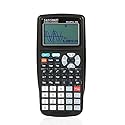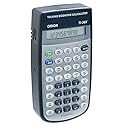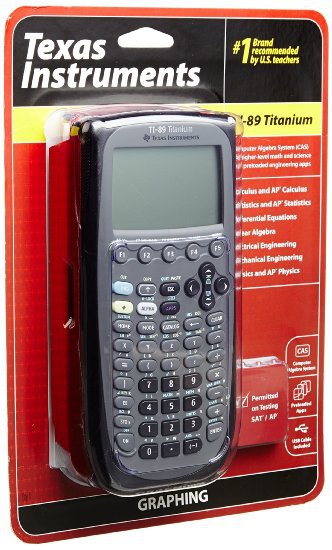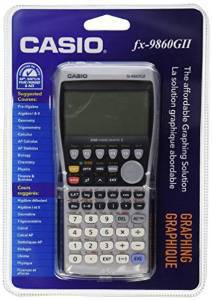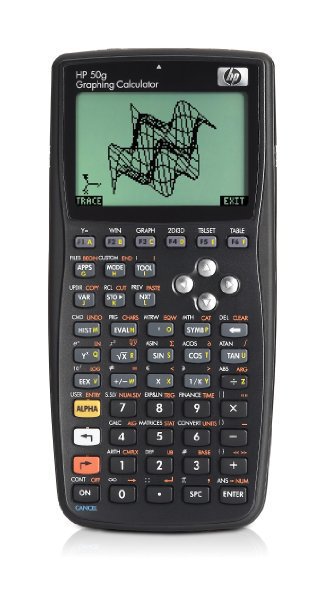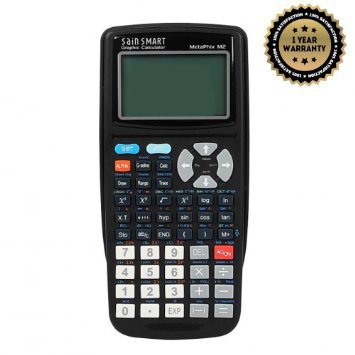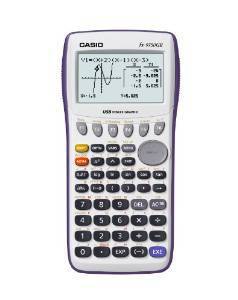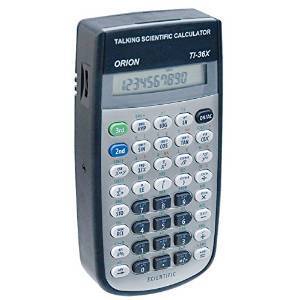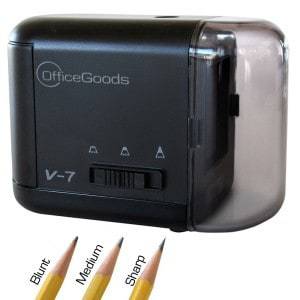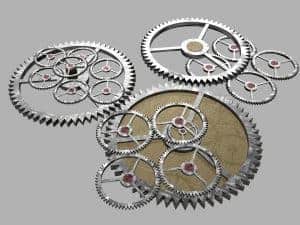From Basic Equations To High End Functions: Take A Look At The Top 7 Best Calculators For Calculus

Students in High School and College who are taking calculus and advanced algebra are always on the lookout for the best calculator. These calculators can be both scientific and graphing calculators.
The more popular graphing calculators have the ability to graph lines and curves for numeric functions; be it Cartesian, polar or parametric coordinates. They have in-built programs to solve basic equations and can also be programmed for more complicated equations.
Top 7 Best Calculators For Calculus Reviews – Comparison Table
#1 – Texas Instruments TI-89 Titanium Graphing Calculator Review – Our Top Pick
** Editor’s Choice – Best Calculator for Calculus **
The TI-89 is a graphing calculator1 from Texas Instruments which is a leading provider of scientific instruments for students. It has been designed to handle most functions in calculus, algebra, matrices, and statistics. It has a 188kB RAM and a 2.7MB flash memory which ensures above average speeds for calculations and a great deal of storage space for storing downloaded programs. It also has a program editor which allows a user to develop custom programs.
It has a large 100×160 pixel screen which is easy to read and use. It has 3D graphing capabilities. However, the contrast could have been better. It has a graphic based user interface which is much easier and simpler to use than many of the other calculators on the market today.
This is a smart graphing calculator with many apps available online for download using the USB on the go technology which allows you to connect this device to other calculators and PCs. The support website comes with videos which help you become familiar with the device and its functionalities. However, the smart functions make this phone ineligible in some test situations.
The body is made of toughened plastic which is strong and durable. It comes with a 1-year warranty.
Click Here For Price and More Details
#2 – Casio fx-9860GII Graphing Calculator Review
** Best Budget Calculator for Calculus **
A powerful yet affordable graphing calculator from one of the world’s leading manufacturers of calculators, Casio, the fx-9860GII Graphing Calculator can be used by a student for all subjects including algebra, calculus, trigonometry, statistics, biology, physics, chemistry and business & finance. It is one of the top permitted calculators on the PSAT/NMSQT, SAT and ACT college entrance exams and AP tests.
It is a powerful device for its size with a 64kB RAM and a 1.5MB flash memory which ensures high-speed calculation and enough storage space for all the required functions and apps. It comes with a preloaded geometry application and a rare spreadsheet application.
The 64×128 pixel LCD screen is backlit for better visibility and clarity. Though smaller than other screens, it is clear and both graphs and tables can be seen on the screen simultaneously for greater precision.
It has one of the largest online support for apps and functions of any Casio devices. It has a USB port which allows for easy transfer of data between devices and PCs. It has a textbook input mode and a CAS input mode. It is supported both through email and on the telephone.
It is a rugged device which comes with a 1-year warranty. It is an affordable graphing calculator.
Click Here For Price and More Details
#3 – Texas Instruments Nspire CX CAS Graphing Calculator Review
The Nspire CX CAS is one of the most powerful graphing calculators from the world leader in calculation devices Texas Instruments. It has a 16 MB RAM and a 20 MB memory which accounts for it high calculation speeds and ability to store and manipulate complex programs/apps. This is higher than any other calculation devices on the market today.
This speed when combined with one of the largest screens (320×240 pixels) in the market, which can be split 4 ways, allows you to do multiple calculations in different sections of the screen. This device also comes with a touchpad and a stylus which acts like a mouse allowing a user to manipulate between screens. The screen is also in full color with a backlit display which allows for greater visibility and clarity. It is also 3D graph-compatible.
This device comes with a rechargeable battery which lasts for over 2 weeks (normal use) on a single charge. The battery uses a wall adapter for recharging. It comes with a USB port which allows a user to download apps/programs from PCs and other devices and to print saved work.
However, the larger screen and the touchpad have made the keypad a little more difficult to use as the keys are now closer together leading to unintentionally pressing buttons.
It is a little more fragile than other TI devices due to the touchpad and a larger screen. Its support level is as good as any other TI devices, however, the number of apps is less as this is a new device. This will be sorted out in a short time. It comes with a 1-year limited warranty.
Click Here For Price and More Details
#4 – HP 50g Graphing Calculator Review
The 50g is a graphing calculator from Hewlett-Packard, a well-known company for electronic devices. The 50g comes with over 2300+ built-in functions which will cover the range from algebra to calculus and to physics and chemistry, everything a science or math student may need in high school and college. It comes with a 512Kb RAM and 2MB flash memory which allows for fast calculations and reasonably large storage space for functions and apps. The best part is the added SD card provision which not helps increase memory functions but also helps transfer data between devices and PCs. It also has a USB port for data movement.
It has a 131×80 high-resolution screen which is easy to read. It is slightly smaller than other devices but is large enough for a clear display of graphs. It also has 3D graphing capabilities.
The user has a choice in input method – RPN, CAS or textbook. The only problem with this device is that it is not as popular as the devices from Texas Instruments and hence is not as used as frequently during classroom instructions as TI devices.
HP devices always have a great support system on email, telephone and chat and this device is no different. It comes with a 1-year limited warranty.
Click Here For Price and More Details
#5 – SainSmart MetaPhix M2 Graphing Calculator Review
The MetaPhix M2 from SainSmart is one of the cheapest graphing calculators on the market today. This could be because it is manufactured in China.
It is a decent scientific calculator which can be used for algebra and calculus. It has a huge number of inbuilt functions. However due to its small screen (64×32 pixels), graphing is a bit difficult and also tedious as you have to keep pressing buttons repeatedly. Also, the secondary functions are a little difficult to read.
It does not have a manual power on/off button but does have an auto shutoff feature which helps in saving power.
It comes in a toughened case which is durable and comes with a 1-year warranty. It comes with a detailed technical manual which is needed as this device has different functionalities as compared to all other devices on the market today. No information is available on its memory which makes it a bit suspect.
However, despite all its flaws, this graphing calculator is a great buy for those students who are just starting algebra and calculus and do not require high-end functions.
Click Here For Price and More Details
#6- Casio fx-9750GII Graphing Calculator Review
One of the more affordable graphing calculators which can be used by students for algebra, calculus, trigonometry, physics, chemistry, and biology; the fx-9750GII Graphing Calculator is manufactured by world’s leading producer of calculators, Casio. It also has a lot of functions like depreciation calculations, which allow it to be used as a finance or business calculator. This is one of the few advanced graphing calculators which are allowed for almost all the tests including P-SAT/NMSQT, SAT, and ACT college entrance exams and AP tests.
It, however, has the lowest memory stats of all the reviewed devices with a 26kB RAM and a 26kB memory. However considering the usage requirement of this device, this memory is quite adequate. It is extremely easy to learn and use, especially for a first time user of graphics calculator as it is one of the simplest calculators in the market today.
It has a screen resolution of 64×128 pixels which is quite adequate for its functionality.
Casio has a strong support system for both email and telephone. It also has a great online teaching and support website which allows for easy usage of the device. This is a rugged device which comes with a one year warranty.
Click Here For Price and More Details
#7 – Orion T136X Talking Scientific Calculator Review
One of the only scientific2 and non-graphic in this review, the T136X Talking Scientific Calculator from Orion is based on the TI-36X Solar Educational Calculator by Texas Instruments. The TI36X is one of the most popular and widely used calculators in the US schools, and so it is easy for teachers and students alike to learn, to teach and to use. This scientific calculator is permitted to use in College Board Tests: AP, SAT and PSAT/NMSQT
It has over 127 scientific functions including 1 and 2 variable statistics, trigonometry and unit conversion. It has an LCD display. It has a rechargeable battery which lasts for 6 hours of continuous usage.
It is a talking calculator which has been designed to help the visually challenged.
The calculator comes with a 1 year warranty0.
Click Here For Price and More Details
The Ultimate Buyer’s Guide To Choose The Best Calculators For Calculus
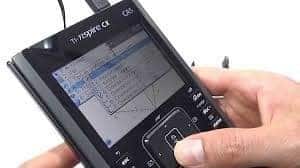
A graphing calculator is an electronic machine in the hands of students, which means it needs to be both functional and durable. Let us look at some features that you need to consider while purchasing one:
Type:
There are two main types: Normal and Smart. A “Normal” calculator can be used to solve smaller equations whereas a “Smart” calculator can be programmed, or programs downloaded to solve most complex equations. Normal Calculators are allowed in most classrooms and tests (SAT etc.) whereas Smart Calculators are not.
Memory:
As an electronic device, the memory both RAM and ROM are essential to its functioning. Higher the memory, faster the device works and can store more programs.
Input Method:
The two choices are computer algebra system (CAS) which can solve symbols based problems or non-CAS methods like Reverse Polish Notation (RPN) which use numeric expressions. For complex equations, CAS is required.
Screen Resolution:
For ease of use, the screen has to have a good resolution, so that the solutions and graphs can be read easily. It should have a high-contrast readout.
Button Layout:
Should be easy to use with much-used function keys easy to access.
Durability:
Should be made of a tough material which can handle rough usage the device is going to be put through by students. It should not get scratched when putting in a backpack with other student items.
Support and Warranty:
As with any other electronic device, the calculator should come with easy to access support systems, easy to find and download programs/apps and a good warranty.
Budget:
These calculators are long-term investments for some students and for others short-term investments. So depending on your current and future use, select the budget for your calculator.
Also, remember if you are planning to use it for an exam like SAT/ACT, then confirm on the website if your choice of calculator can be used. These exams prohibit those calculators “with built-in or downloaded computer algebra system functionality”.
You can purchase these calculators at any school or office supplies stores which also sell electronic devices. But if you want great discounts and best deals look online on websites like Amazon.com.
References
- https://en.wikipedia.org/wiki/Graphing_calculator
- https://en.wikipedia.org/wiki/Scientific_calculator




